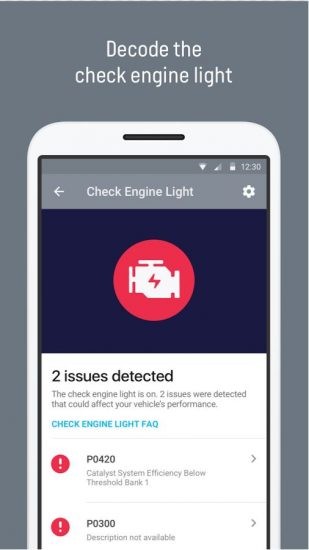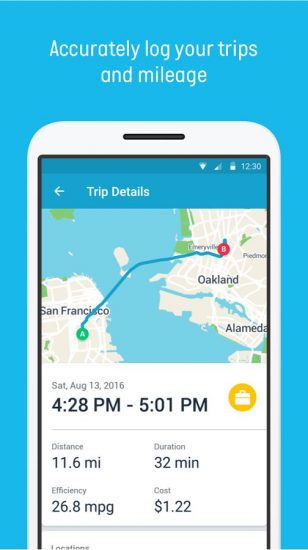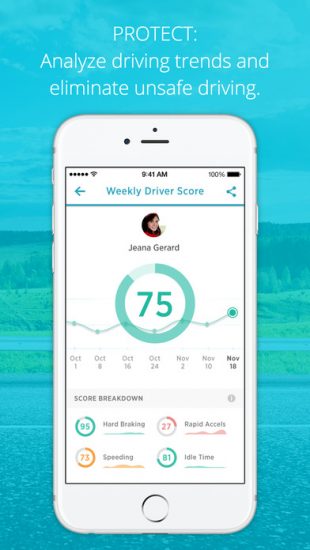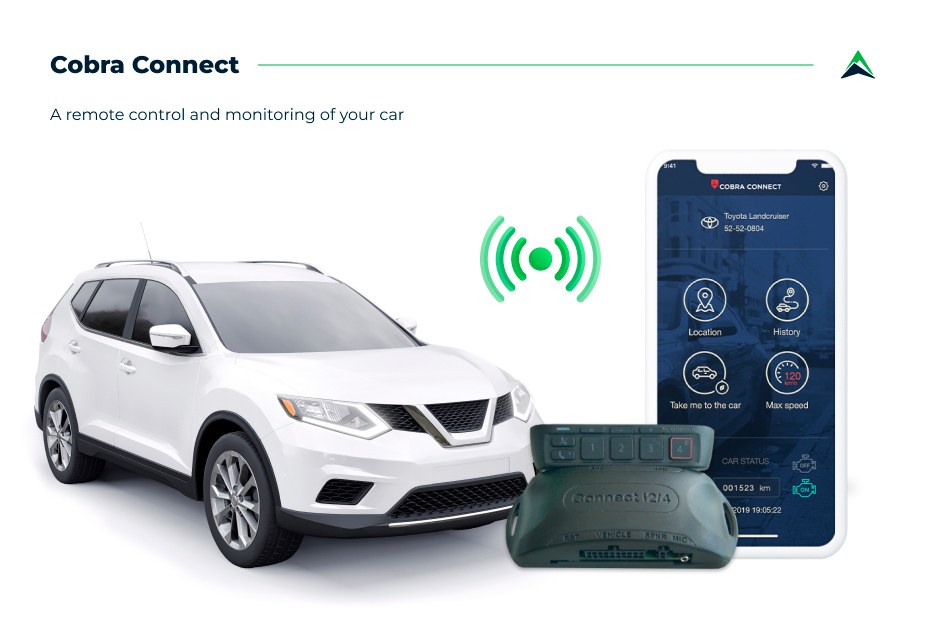The article was updated on March 17, 2023.
By the end of 2019, the amount of time that Americans had spent driving increased by 8% and reached 70 billion hours annually. All in all, Americans drive 11,498 miles per year, and spend hundreds of hours behind the wheel. That makes the automotive market a highly lucrative niche for connected car app development. In fact, by 2025 the connected car market size is predicted to reach $166 billion.
In this article, we will make an overview of some of the most popular connected car apps and uncover the specifics of custom car apps development. Read on to learn more!
What are connected cars?
Before we move on, let’s explore how connected cars work. The term ‘connected cars’ refers to cars with Internet connectivity. Such vehicles can easily connect with IoT devices, exchange data, download software for various needs, and provide passengers with WiFi. From entertainment to important updates, connectivity takes the driver’s experience to an entirely new level.
The main advantage of connected cars is data sharing. Understanding how cars make use of data is critical to understanding how automotive apps work. So let’s take a look at the type of data gathered with connected cars.
The interchange of data works on five levels:
V2I (Vehicle to Infrastructure): as the name implies, on this level, a car communicates with the surroundings to get info about road situation, accidents, road construction, parking places, etc.
V2V (Vehicle to Vehicle): On this level, the cars “talk” to each other about their location on the road to avoid traffic jams and accidents.
V2C (Vehicle to Cloud): This refers to a vehicle interchanging data with cloud analytics platforms. The car sensors collect data and send it to the cloud for processing. The cloud-based analytics platform then provides the driver with various insights – from important real-time data to predictive maintenance analytics.
V2P (Vehicle to Pedestrians): This type of data exchange helps protect pedestrians by locating them on the road and informing other drivers about their presence with smartphone notifications.
V2X (Vehicle to Everything): On this level, the data interchange takes place between a car and other objects on the road such as traffic lights, road markings, and traffic signs.

The rise of the connected car: A business case for automotive technologies
Despite the fact that the automotive IoT market is only emerging, it is estimated to be worth $82.79 billion by 2022.
And there is a good reason why more and more businesses are starting to invest in related projects. The demand for connected car technologies is growing. Automotive IoT solutions offer a simple and affordable way to upgrade any car.
Some of the benefits that such apps provide to users include the following:
Real-time vehicle monitoring and breakdown prevention
By using V2C connection, a smart car app receives instant notifications about the condition of the car’s core systems and takes timely action to prevent malfunctions. The timely access to data is one of the main benefits of connected cars since it helps to dramatically reduce the costs of maintenance.
Increased car efficiency and safety
Real-time monitoring gives drivers more control, as they stay informed on the state of their vehicle. The data-driven approach enables them to schedule repairs and avoid unexpected breakdowns. Managing a fleet of vehicles, for example, becomes easier and more efficient when managers can track the location of multiple cars and identify which of them need maintenance.
The ability to augment a vehicle’s in-built capabilities with third-party tools
Advanced navigation systems, locating free parking spaces, spotting pedestrians, avoiding traffic jams, AI-driven security, and in-car entertainment systems account for the enhanced driving experience. Users of connected car apps can benefit from receiving cashbacks and discounts for services available through third-party integrations.
Safe driving
Via V2I, V2V, and V2X connections, smart cars stay informed regarding the road infrastructure and the closest surroundings, and automatically adjust their route and speed according to the real-time data. This dramatically reduces the number of accidents, eliminates congestion, and creates a better and safer traffic situation.
Positive influence on the community and the environment
Predictable and safer driving will enable more people to carpool, which may potentially increase the number of vehicles on the roads. Smart routing capabilities will enable drivers to reach their destinations faster and more efficiently which will reduce car exhaust emissions. On top of that, physically impaired people will be able to use connected cars, so that driving becomes more accessible.
Cost-effectiveness
Ultimately, one of the ways connected cars will transform our lives will lie in increased cost-effectiveness. Although a connected car is not cheap and automotive app usage comes at a price, the overall effect of fuel and time saved thanks to using automotive app solutions will be hard to underestimate.

At the same time, businesses also have many reasons to invest in automotive IoT:
- Monetization and demand: While most apps on the AppStore are free or come at a cost of 99 cents, automotive apps are usually priced higher. This gives businesses an opportunity to easily monetize their products.
- Third-party integrations and partnerships is another revenue channel for automotive app developers. By selling access to your API to other businesses, you can achieve greater ROI. You can even develop partnerships directly with car manufacturers so your devices will come pre-installed in all vehicles.
- Collecting and using data: As with any IoT device, automotive products allow you to tap huge amounts of user and vehicle data. With it you can source valuable insights and tailor your product accordingly. The data can also be provided to third-party businesses operating in related domains: insurers, repair shops, roadside assistance providers, etc.
- The first-mover advantage is one more reason to enter this market right now. Both existing automotive businesses and users are eager to see more innovations in this sphere, so the barrier for entry is fairly low at the moment.
There are many ways automotive apps can level up your vehicle. The existing examples available in the app store tend to focus on such features as GPS and navigation, safety, vehicle maintenance, fuel consumption and mileage logging, voice and gesture control, and multimedia access.
Notable examples of connected car apps
Some of the best car apps currently available (according to users’ opinions) are listed below.
1. Automatic
- Product type: IoT, automotive maintenance app.
- Hardware: Custom car adapters (Automatic Lite and Pro)
- Target platforms: iOS, Android, and web.
Key features: Trip logging, vehicle diagnostics, fill-up logging, Bluetooth/3G syncing, crash alert, parking and live vehicle tracking, and third-party apps (Lite plan has limited features)
Third-party integrations: Large portfolio of apps and services to augment the core app features.
The company provides an API for businesses and developers to build custom car apps that integrate with Automatic.
App monetization model: The automotive cloud platform is available for maintenance and repair service providers, and insurers (usage-based insurance, pay-per-mile insurance, safe driving incentives, and teen safety programs).


2. Dash
- Product type: IoT, automotive maintenance app
- Hardware: Preferred device as well as a number of supported third-party Bluetooth-enabled OBD devices
- Target platforms: iOS and Android.
Key features: Detailed trip logs, real-time car monitoring and diagnostics, ability to locate the cheapest gas stations and repair shops nearby, social features (social media sharing, rewards, leaderboard), estimates and scheduling for car repair, and driving suggestions.
Third-party integrations: Integrates with other apps using IFTTT recipes.
App monetization model: Its proprietary API, Chassis, can be accessed by third-party businesses to build insurance, fleet management and after-market solutions.
3. Zubie
- Links: Web, App Store, Google Play
- Product type: IoT, automotive maintenance app
- Hardware: Custom device (comes in 2 variants: with cellular service only, and with cellular + in-car Wi-Fi hotspot)
- Target platforms: iOS, Android, and web.
Key features: Real-time driving insights, tips, and alerts, maintenance alerts, engine diagnostics, roadside assistance, repair estimates & shop listings, real-time vehicle location, trip tracking, motion monitor (security), discounts and gas station map. Optional: in-car Wi-Fi hotspot.
Third-party integrations: Connects to a number of third-party apps and services.
App monetization model: There are three plans available for a user: Personal, Business and Enterprise. The Personal plan also has a family option. The Business plan includes a complete fleet management solution (the ability to track the vehicle’s location, its condition, and monitor the driver’s performance, as well as API access to integrate the platform with the internal systems). The Enterprise plan is tailored for insurers and auto dealers, and it provides data-based analytics and insights on request.


4. Navdy
- Product type: IoT, driving apps, driver-assist technology, and augmented reality.
- Hardware: Custom device (Navdy portable head-up display and Navdy Dial remote control button)
- Target platforms: iOS and Android.
Key features: Gesture/voice control; basic phone features including calls, messages, music, notifications, and calendar; navigation and Google Maps search; car maintenance information including speed, RPM, and fuel level.
Third-party integrations: None. The app accesses basic features of your phone like Maps, Calls, Messages, Notifications, Music, etc. (via Apple Music, Pandora, and Spotify).
App monetization model: No paid membership: Apps are free to use as soon as you buy the required hardware.
5. GoFar
- Links: Web, App Store, Google Play
- Product type: Bluetooth OBD2 Connected Car Adapter
- Hardware: Bluetooth OBD2 Connected Car Adapter, GOFAR Ray (dashboard device)
- Target platforms: iOS and Android
Key features: Automatically logs mileage for easy tax and expenses, economy display, speeding alerts, diagnostic alerts, real-time feedback to keep new drivers safe.
Third-party integrations: Export data to CSV
App monetization model: App is free unlike hardware.

Connected car trends
The future of connected cars will surely depend on further sophistication and development of technologies like AI, IoT, smart sensor and onboard computer technology (5G and advanced car connectivity protocols).
Today, some of the most prominent trends in connected vehicle technology include the following:
1. Telematics
In the upcoming years, we can expect to see a rise in vehicle telematics systems, which is extensively used in connected car apps for fleet management. Telematics, a term coined from a combination of telecommunication and informatics, helps track the parameters like car location, speed, fuel consumption level, the state and overall integrity of its systems, idling time, and much more.
In the future, telematics will be paramount to evaluating driver behavior, and the telematic assessment will play a key part in underwriting car insurance packages.
2. Self-driving cars
Self-driving cars are autonomous vehicles that can ride, fully or partially, without human intervention. Also known as driverless cars, such vehicles use a range of technologies to perceive the surroundings. The use of GPS, sonar, radar as well as V2I, V2V, V2P, and V2X data enables cars to make smart choices based on the information they receive.
Although the first driverless car launch already happened in 2019, a complete driverless car adoption will depend on the development of road infrastructure and is not to be expected within the upcoming 10 years.
3. AI interfaces
Imagine Alexa or Siri built-into your car infotainment system, listening to your instructions and bringing you valuable insights and advice. Furthermore, this built-in AI system can monitor the state of a driver and their behavior, learn from experience, anticipate the driver’s needs and create seamless and satisfying human-vehicle interactions.
Automotive giants like Toyota and Audi are already working on such systems; on top of that, AI interfaces will be playing a key part in the autonomous driving experience.
4. Smart sensors and the IoT
Connected car technology is highly dependent on smart sensors, which play an important part in the V2C (vehicle to cloud) data exchange. The sensors track the state and performance of the car’s engine, brakes, and transmission systems, forward the collected data to the cloud so that the analytics software could process them into valuable insights. Smart sensors and IoT coupled with Artificial Intelligence is the technology that is shaping the future of connected cars.
5. A fully connected car
By now, almost 90% of all the newly manufactured cars come with Internet connection and cloud access. As connected cars become mainstream, internet connectivity will start to be perceived as one of the most vital modern car systems, equally important as the engine and the steering system. While self-driving cars are still far from becoming omnipresent, a totally connected car is already a new normal.
6. B2V connectivity
Finally, let’s take a peek into the dim and distant future. B2V stands for Brain to vehicle connectivity, when a smart car will measure the human brain wave activity, read into a driver’s intentions, and adjusts accordingly.
If you think this is stretching connectivity too far, think again: by tracking the driver’s brain activity, a car can intercept control if the car is being driven unsafely, detect dangerous road situations and make the necessary adjustments. The implementation of this technology, however, requires cumbersome wearable hardware – a headset pressed tightly to a driver’s skull to capture brain activity.

Tips on developing custom car apps: First-hand experience
We at Eastern Peak have successful hands-on experience building IoT car maintenance apps and can provide advice on some of the best practices for building automotive apps. Namely, there are several aspects to consider.
1. Clearly set goals and explain them to your developers
When building custom car apps, the product specification stage is very important.
First of all, you need to define which ideas fully meet your business requirements, which features will add a unique value or bring the highest ROI for your specific business in the long-term outlook.
Read also: How to Create a Mobile App Specification
Discussing your view of the future product with developers directly helps you actually brainstorm development and business strategy challenges. Additionally, it will aid you in identifying possible technological limitations, and finalizing your requirements.
Your project managers should be able to help you navigate the possible pitfalls, provide expert advice on how to better implement your vision, and find the most optimal solution for you.
Getting your app development team engaged in the project during the early stages helps you create a better product.
2. Consider the specifics of your car app design
Car app design has some specifics. Namely, driving apps require
- a clear and plain UI,
- voice/gesture commands (to keep your eyes on the road), and
- minimum distractions for the user.
Thus, hiring a designer who has relevant experience is a must.
3. Choose the right technology stack
Car app implementation has some specifics. Depending on the type of product you want to build, you should be able to do the following:
- integrate your app with the on-board car computers using specific hardware devices, and
- configure the communication between the Android/iOS app and the car application through different connection protocols (for apps designed to control the car from smart phones).
Read also: Developing apps for Android Auto
Thus, the choice of your technology stack depends primarily on the target audience and the specifics of your product itself, be it an app for Android Auto/Apple, CarPlay/standalone, or a cross platform app.
To make the right decision about the appropriate technology stack and product type, target audience research is required. Your development team will advise you on the pros and cons of each approach, depending on the functionality you want to implement.
In addition to the great number of programming languages you can use, there are also third-party APIs you can integrate with or complete IoT platforms that can serve as a basis for your app.
However, the latter might cause serious scalability problems down the road, requiring much more ongoing expenses than a custom solution built specifically for your business would.
Take into account that building a scalable product requires more development time. However, it’s mandatory if you consider the future growth of your startup.
4. App development and testing
At this stage, all the features are implemented in the code. The app should be thoroughly tested for all possible bugs and compatibility issues (this is especially important for hardware-software integration and accuracy).
Thus, the most important thing here is to choose an experienced and reliable technology partner and let your team do the rest.
At Eastern Peak we apply the Agile methodology to minimize the risks and speed up the development process.
Side note: Building a simple iOS/Android app for car owners isn’t that difficult. Most developers will be able to handle such a project. However, creating an app that integrates with the car’s hardware directly or via third-party connected devices requires specific skills and niche expertise. In this case you’ll need developers who have experience building such automotive apps, integrated with car’s control systems and on-board computers.
Our experience in developing apps for cars
Cobra Connect is a comprehensive IoT solution that allows users to take full control of their vehicle, monitor its condition, and operate it remotely.
Cobra comes in just three main pieces: a box with an alarm system and internet connectivity to install in a car, a mobile application for users, and a control console.
Drivers can use the application to open and close car doors, engage the alarm, disarm the alarm using a code or their fingerprint, get reports for each trip that includes the duration, distance, and speed, locate the car on the map, turn the emergency lights on or off, and get notifications about the status of the car and its components.

Conclusion
The automotive market right now is in a state similar to where smartphones were back in 2010. The industry is just shaping up and we are still yet to see it take off. That is why right now might be the best chance for a business to enter this emerging market and capitalize on the opportunities it provides.
Namely, PWC research finds that there is a huge opportunity for the new entrants to capture a part of the $120 billion worth market share, as “many of today’s manufacturers and suppliers lack the skill, agility, and boldness to turn their companies digital quickly enough to take advantage of this change.”
How to get started?
The product discovery phase is the best first step you can take to lay a solid foundation for the development of your app. It includes a functional specification, UX/UI design, and a visual prototype that will give you a clear vision of the end product. On average, this phase takes 4-6 weeks.
The product discovery phase can help you:
- define a full scope of work and develop a roadmap for the project
- set a realistic budget for your MVP and plan your resources
- test the waters with your audience using a visual prototype
- craft a convincing investment pitch
- get to know your team
We at Eastern Peak have the skills and relevant experience building complex solutions in the IoT in general and automotive sphere specifically. This makes us a go-to technology provider for both startups and enterprise companies looking for car maintenance app developers.
To get professional advice on how to build your own automotive app, book a free consultation with our team today.
Read also:


